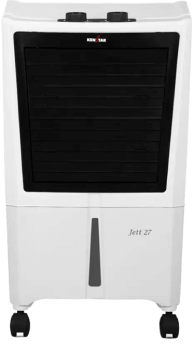Cooling Pad Showdown: Honeycomb vs. Wood Wool

Two decades ago, the Indian summer was synonymous with the rhythmic hum of bulky desert coolers. These units, often constructed with metal bodies and wood wool pads, were a staple in households, providing relief from the scorching heat. However, they came with their set of challenges: frequent water refills, susceptibility to rust, and limited cooling efficiency.
Fast forward to 2025, and the landscape of air cooling has transformed dramatically. Modern air coolers boast sleek designs, energy-efficient technologies, and smart features that cater to the diverse needs of contemporary consumers. This evolution is not just a testament to technological advancement but also reflects the changing preferences and lifestyles of Indian consumers.
The Traditional Era: Function Over Form
In the early 2000s, air coolers were primarily functional devices. Their design prioritized utility, often at the expense of aesthetics and user convenience. Key characteristics included:
-
Basic Cooling Mechanism: Utilizing wood-wool pads and large fans to circulate air.
-
Manual Operations: Limited to basic speed settings and lacking remote controls.
-
Maintenance Challenges: Prone to rust and require regular cleaning.
-
High Water Consumption: Frequent refilling due to inefficient water usage.
Despite these limitations, these coolers were indispensable, especially in regions with dry climates.
The Modern Age: Smart, Efficient, and User-Centric
Today's air coolers are a blend of innovation and user-centric design. They address the shortcomings of their predecessors while introducing features that enhance user experience. Notable advancements include:
-
Energy Efficiency: Brands like Kenstar have incorporated Brushless DC (BLDC) motors, which consume up to 60% less electricity as compared to traditional motors.
-
Enhanced Cooling Pads: Air cooler use of honeycomb cooling pads in that offer better water retention and cooling efficiency.
-
Smart Features: Integration of remote control and multiple speed settings.
-
Aesthetic Designs: Sleek and modern designs that complement contemporary home interiors.
-
Low Noise Operation: Advanced motor technology ensures quieter performance, making them suitable for bedrooms and offices.
Consumer Insights: What Buyers Value Today
The modern consumer is informed and discerning. Beyond just cooling, they seek air coolers that align with their lifestyle and values. Key considerations include:
-
Energy Savings: With rising electricity costs, energy-efficient appliances are in demand.
-
Smart Features: Convenience-driven features like remote controls and timers are highly valued.
-
Aesthetic Appeal: Appliances that blend seamlessly with home decor are preferred.
-
Eco-Friendliness: Products that minimize environmental impact resonate with environmentally conscious consumers.
Conclusion: Embracing the Future of Cooling
The journey of air coolers over the past two decades reflects a broader narrative of technological advancement and changing consumer preferences. From rudimentary devices to sophisticated appliances, the transformation underscores the importance of innovation in enhancing everyday comfort.
As we look ahead, it's evident that the future of cooling lies in smart, efficient, and user-centric designs. Brands like Kenstar, Crompton, Symphony etc. are at the forefront of this evolution, offering solutions that not only cool our homes but also align with our modern lifestyles.
Kenstar has a strong service support network across India to ensure prompt service and maintenance of your appliances, and 350+ service centers across India.
Kenstar has a strong service support network across India to ensure prompt service and maintenance of your appliances, and 350+ service centers across India.
www.kenstar.in/service-centres.
Email your service request to customercare@kenstar.in




